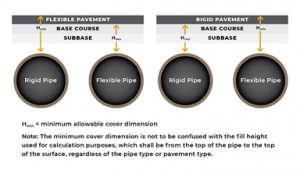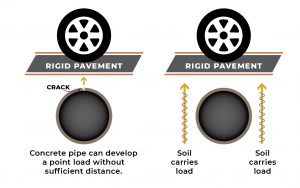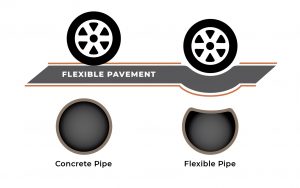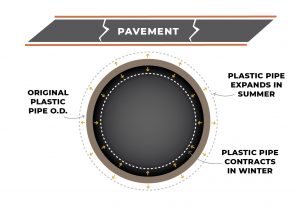By Josh Beakley, P.E., ACPA Vice President of Engineering
It’s not unusual to have a buried drainage pipe with minimal cover. This cover may be soil, flexible asphalt pavement, or rigid concrete pavement. At the American Concrete Pipe Association (ACPA), we often hear the question: “What’s the minimum allowable depth of cover for a buried pipe?”
Some engineers may simply look at fill height tables and assume the lowest depth of cover in the table is the acceptable minimum. This assumption would be a mistake. In fact, “minimum cover” and “fill height” are actually two completely different things. As the American Association of State Highway and Transportation Officials (AASHTO) notes, “The minimum cover dimension is not to be confused with the fill height for calculation purposes.” So, what’s the minimum allowable depth of cover for a buried pipe? Well, it depends on the type of pipe and what material covers it.
Let’s begin with what the minimum cover requirements are, and then we’ll provide a brief explanation for these differences.

Minimum Cover as Denoted by the AASHTO LRFD Bridge Design Specifications
In accordance with Section 12.6.6 of the AASHTO LRFD Bridge Design Specifications, 9th Edition, the minimum cover for a rigid pipe such as reinforced concrete pipe (RCP) is the greater of 1/8 the outside diameter of the pipe or 12 inches, when there is only soil or flexible pavement above it. When a rigid pavement is over the concrete pipe, the minimum cover is 9 inches from the bottom of the pavement. Thus, the minimum distance from the surface to the top of a concrete pipe under rigid pavement depends upon the pavement’s thickness.
Keep in mind these minimum values apply to RCP designed in accordance with Section 12 of AASHTO. Concrete pipe is not a one-design-fits-all product. Thus, covers less than the minimum can be accommodated, but they require a special design outside of the method provided in AASHTO.
Also, in accordance with Section 12.6.6 of the AASHTO LRFD Bridge Design Specifications, 9th Edition, the minimum cover for a plastic pipe is the greater of 1/8 the inside diameter of the pipe, or 12 inches in unpaved areas. For locations with pavement, the minimum cover is the greater of ½ the inside diameter or 24 inches.
It is also imperative to realize that the cover for flexible pipe is measured from the bottom of flexible pavement, and from the top of rigid pavement, which is totally opposite of what it is for rigid pipe.
Most engineers are aware that rigid and flexible pipes function differently in the soil-structure system. However, many often forget this not only affects how the pipes react to earth loads, but how they react to live loads as well.
For a rigid pipe, most of the structure is provided by the pipe itself, so the pavement does not have to be strong enough to spread the live load over the pipe in a shallow condition. The concrete pipe is capable of handling the additional concentrated load (i.e., unlike flexible pipe which relies heavily on proper bedding and backfill to achieve structural integrity).
Keep in mind: When the pavement is rigid enough to spread the live load to where it will develop a reaction with the stiffest element or elements underneath it, the concrete pipe is much stiffer than the surrounding soil and will thus be a reaction point for the rigid pavement. That’s why there’s conservatively a minimum of 9 inches of soil cover required between the top of the concrete pipe and the bottom of the rigid pavement.

In the case of rigid pavement, the rigid concrete pipe serves as a reaction point to the load, whereas, for flexible pipe the rigid pavement must bridge over the pipe to the relatively stiffer, surrounding road base.
Contrast this with flexible pipe, such as plastic pipe. With rigid pavement over the plastic pipe to bridge its weakness, the pavement will spread the live load to where it develops a reaction with the stiffest elements underneath it, which in this case is the soil, or road base, surrounding the pipe.
Thus, the distance between the bottom of the rigid pavement and the plastic pipe is not as critical However, when plastic pipe is installed beneath a flexible pavement, you’re likely to have dips in the road surface if you don’t maintain a sufficient amount of cover between the top of the plastic pipe and the bottom of the flexible pavement.

In the case of flexible pavement, the load can pass through the pavement and soil to the rigid concrete pipe which supports it. However, a flexible plastic pipe may not be able to support the live load.
Incidentally, many engineers aren’t aware that the minimum cover requirement of ½ the inside diameter of the plastic pipe when it is under the pavement is actually a function of the pipe material’s thermal properties. Plastic’s coefficient of thermal expansion is so high that the expansion and contraction of plastic pipe through the seasons will result in settlement above the pipe that damages the road surface unless a sufficient distance is maintained between the pipe and the pavement.

For plastic pipe, the thermal expansion and contraction of the pipe due to changes in the weather can have a detrimental effect on the pavement above
One final note before we leave this subject. When performing calculations, or pulling values from fill height tables, “fill height” is always taken from the surface down to the top of the pipe. As long as you have maintained the appropriate minimum cover requirements of AASHTO, then the designs based on fill height will be appropriate.
Remembering these guidelines for minimum cover can help avoid damage to the roadway from live loads traveling over it. Additionally, if the pipe beneath the roadway gets damaged as well, then the flow of water beneath the roadway may get altered, thereby resulting in water damage in areas adjacent to the road.
For assistance designing your culvert or for any other questions about concrete pipe, we’re always happy to help. Contact the ACPA at info@concretepipe.org.
